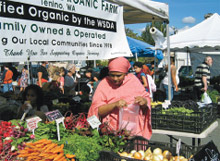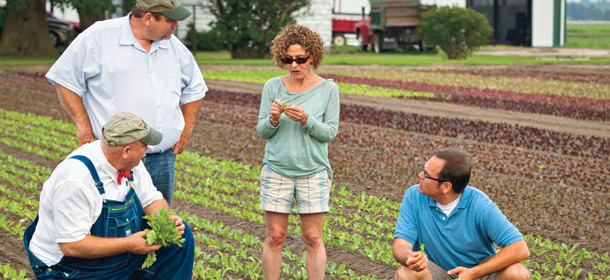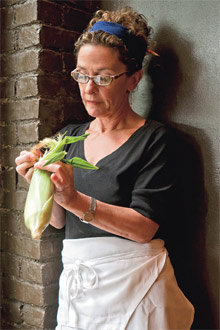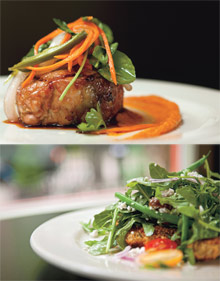This story appears in the October 2011 issue of Entrepreneur. Subscribe »
As the summer sun glints off a pyramid of scarlet-and-yellow Rainier cherries, at least one customer can't contain himself. "I know I can't buy yet, but can I sample?" he asks. It's Wednesday afternoon in July in Seattle's Columbia City neighborhood, and the weekly farmers market--one of 40 in King County alone, up from nine a decade ago--is set to begin. Customers mass around the two blocks of stands, ogling bok choy and baby turnips, positioning themselves to get the ripest tomatoes. At 3 p.m., a bell rings to open the proceedings. Almost immediately, money flies across tables in flashes of green.
Think farm-to-table dining, and you may envision tree-hugging elitists rolling up to urban markets in expensive cars to fill cloth bags with expensive lettuce and free-range chicken. But look closer. The Columbia City customers are a disparate lot. Many are immigrants, going stall to stall to buy produce as they did at home. Others live in downtrodden neighborhoods nearby, one reason that this market has recently started accepting food stamps.
"A lot of people here don't fit the stereotype," says Lauren Keeler of Columbia City Bakery, which sells breads and cakes made just down the street. "It's not just some kind of yuppie thing. We get Asian immigrants, African immigrants, middle class, lower-middle class. It's amazingly diverse."

Locally sourced food is a big deal in Seattle, and the economic tendrils of the movement reach deeper than anyone might imagine. Throughout the city, in one ZIP code after the next, you'll find restaurants that have made local ingredients both a guiding principle and a marketing tool--from Local 360 in Belltown to emmer&rye ("seasonally inspired, locally derived") in Queen Anne to Wallingford's Tilth, which is named after the Oregon organization that certifies organic farms.
Foodies flock to Ethan Stowell's Anchovies & Olives, an Italian seafood house on Capitol Hill, and eat their way through geoduck crudo; soft-cooked eggs with capers; king salmon with turnip, asparagus and bacon; and fried oysters with Savoy cabbage, secure in the knowledge that every one of the ingredients in those dishes--and in many others on the menu--comes from nearby farms or fisheries. For Trellis, inside Kirkland's Heathman Hotel, executive chef Brian Scheehser grows vegetables on his own land in Woodinville and occasionally races there himself to replenish his pantry during service.
He has been known to arrive in the dining room with a plate of food and tell a diner, "This spinach was in the ground 24 minutes ago."
At Taste, inside the Seattle Art Museum, Northwest-sourced ingredients reach 89 percent in season, according to executive chef Craig Hetherington. "At the height of the summer," he says, "we're buying from between 50 to 70 different local farms and other purveyors. It drives the woman who does our accounting crazy." Adds Bryan Jarr, co-owner of Seattle's Madison Park Conservatory: "We don't even promote it because people just expect it."

In Seattle, even Chipotle--the fast-food Mexican chain with more than 1,100 units in 35 states--buys extensively from local purveyors, "as high as 85 to 90 percent for some ingredients," according to a company spokesman.
Add it up and you have a profound economic impact. King County farmers markets alone, estimates indicate, gross $30 million annually, and that doesn't include ancillary revenue such as parking lots that surround the markets. Small farms are--forgive the metaphor--sprouting up throughout the area, ringing up annual sales ranging from $10,000 to more than $1 million. "We're talking about a huge section of the economy," says Richard Conlin, president of the Seattle City Council.
But that's Seattle, right? In much of the rest of the country, one might assume, farm-to-table is a niche within a niche, as offbeat and beyond-the-mainstream as vegan meatballs or homemade soap. In reality, though, it's big business almost everywhere.

Consider Cleveland, which nobody would confuse with Berkeley, Burlington or Boulder. Set in the heart of the Rust Belt, the city turns out heavy, Eastern European food--the goulashes, paprikashes and schnitzels favored by immigrants from either side of the Danube. Clevelanders aren't particularly healthy--in 2007, Men's Fitness magazine dubbed the city the "junk food capital" of America--and their income falls below the national average. Whole Foods Market didn't put a store there until it had 183 others positioned around the country.
Yet you'll find farm-to-table dining thrives there, too, often hiding in plain sight. At the popular Fire Food & Drink in Cleveland's Shaker Square suburb, chef-owner Douglas Katz has filled his menu with local products in stealth-like fashion: a squash blossom here, a pork loin there, the eggs, honey and butter in the popovers. By August, when the growing season is in full swing, he'll be spending half his food budget on locally sourced items.
"I don't want to go to Costco and get a package of pea tendrils," Katz says. "I want to go to a grower and establish a relationship. I'm supporting the local economy, my food tastes better--and my customers can tell. In all kinds of ways, it makes sense."
The return of locally sourced produce is a recent phenomenon. At the turn of the 20th century, most of the food that we ate came from within 50 miles of where we were eating it. But as the American demographic shifted from rural to urban, many local food sources disappeared.
Aided by improvements in distribution from interstate highways and overnight shipping, we started looking farther and farther away from home for our food. Or, rather, we weren't looking at all. We'd walk into supermarkets or restaurants and choose from the bounty of products that the big trucks had dumped at our doorstep. Shopping locally inevitably cost more because small growers lacked the economy of scale that industrial farming enjoys. And, until recently, it stood without honor in its own land. Nothing intimated quality in a food item so much as calling it "imported."
That's where we were when the locavore movement began in earnest a decade or so ago. These days, the average metropolitan area in America still grows or raises less than 2 percent of the food it consumes--and it consumes a lot of food, some $15 billion of it in northeast Ohio alone each year, including the breakfast cereals, fast-food burgers, bottled condiments, frozen pizzas and soft drinks that are the staples of many diets. That makes the economic arguments for farm-to-table food compelling. Moving the needle just 5 percent in Greater Cleveland would mean $750 million more in revenue for local purveyors.
The last time a $750 million business relocated to Cleveland was ... well, probably never. So it's easy to see why politicians and policymakers are excited about the possibilities. Recently, five entities combined resources to commission a study by local-business-development analyst Michael Shuman and his two partners on what would happen if northeast Ohio managed to produce 25 percent more of the food it consumed. The report calculated that such a shift would create more than 27,000 new jobs, increase annual regional output by $4.2 billion and grow tax revenue by more than $125 million. "Local food is fast becoming a powerful economic development strategy," it concludes. (See sidebar on page 36.)
In 2007, Cleveland became the first city in the country to zone for community gardens. It also now subsidizes farms in the abandoned city core, turning a blight into an asset while providing access to locally grown produce for a segment of the population that has been deprived of it. This summer, a farm stand opened in a metal shed on the grounds of a 6-acre plot in the middle of Cleveland's Ohio City neighborhood. The stand serves the knot of restaurants within a few blocks' radius, but it's also adjacent to Riverview Towers, a low-income high-rise housing hundreds of families. A Riverview resident now has the opportunity to buy fresh produce just outside the building--closer than the nearest Safeway or Kroger or fast-food outlet--at a 50 percent discount from the regular price.

In Cleveland, too, a landowner can now grow crops and raise chickens and bees without a permit. That makes sense in a city of first- and second-generation Americans.
"As the immigrants died off, all those backyard gardens I grew up with started disappearing," says Karen Small, a Cleveland-raised chef and restaurateur whose Italian grandfather grew crops on a tiny plot behind his house.
These days, Small buys more than $150,000 worth of local meats and produce annually for her Ohio City restaurant, the Flying Fig. She gets much of it delivered, but most afternoons finds time to visit a market, too, to source tomatoes or figs or basil from urban farmers trying to replicate the garden-grown tastes of their youth. "There's a market pretty much every day of the week," she says. "It's a ritual that I can't miss, even though most of my food gets delivered."

Many of the city's restaurateurs feel the same way, along with a whole lot of other people. In 1995, the Shaker Square market opened with six vendors and a handful of curious customers. Now it attracts 60 growers and as many as 4,000 consumers each week and generates $3 million in annual sales.
"And that doesn't count chefs who come here and meet growers and make relationships with them and then set up their own deliveries," says Donita Anderson, who runs the Shaker Square market and six others throughout the area. "Or customers who start at the market and end up with farm shares."
It also doesn't include Dewey's Coffee Cafe, the Shaker Square Popcorn Shop and the other small businesses within walking distance of the market that sometimes serve as many customers on that one day as the rest of the week.
But economic opportunities also exist in the gaps between growers and consumers. Kari Moore doesn't harvest a single vegetable, doesn't run a restaurant and doesn't work at a market. Yet she makes a living through the locavore movement. Her company, FarmShare Ohio, distributes produce from small farmers to retail customers at drop-off points throughout the area.
"People have started to understand the value of local, seasonal eating, and they're willing to pay more to get it," says Moore, who grew up in Seattle, came to Cleveland in 1996 and has been involved in local food since 2002. "I still have to do a ton of education with my customers--and $35 a week for a bag of produce is still too much for a lot of people. But it's an exciting time and, I think, a huge business opportunity. I wouldn't be doing what I'm doing if it wasn't."
The same sense of opportunity is attracting well-educated entrepreneurs to farming. These are sons and daughters from professional families who wouldn't have considered making a living with a rake and a hoe even a decade ago.

In Duvall, Wash., a half-hour east of downtown Seattle, Jason Salvo carries his 1-year-old son, Felix, in a back harness as he helps his wife, Siri Erickson-Brown, tend to business at their Local Roots farm. Both 32 years old, Salvo and Erickson-Brown attended the University of Washington, and earned graduate degrees. (Salvo went to law school at Seattle U; Erickson-Brown has a master's in public administration from UW.) But instead of working in offices, they're out in the field growing 10 acres of turnips and radishes, kohlrabi and carrots. They sell vegetables and herbs to two dozen restaurants, including some of Seattle's best, and have a subscription list of more than 100 individual families. If all goes well, they'll gross $200,000 and net perhaps half to a third of that.
Erickson-Brown has been an entrepreneur of sorts all her life. "I was the kid who made paper valentines and sold them outside when I was 6," she says. She'd been interested in farming since reading books by Laura Ingalls Wilder. But only recently did she realize that she could make a living uniting the two. "Our education has really helped us," she says. "We have a connection to a major urban area. We understand the business model. I mean, there are so many steps that go into a bed of carrots before you actually plant it."
"We're capitalists," Salvo says. "We speak the language of a lot of the people who shop from us."
At the other end of the chain are restaurateurs such as Anchovies & Olives' Stowell, who now has enough sources of local produce that he can depend on it night after night, season after season. None of Stowell's four restaurants are conspicuously farm-to-table, but all source locally, including the authentically Italian Tavolata, which manages to transport diners thousands of miles away even as they eat food largely grown in their hometown.
This year, too, Stowell has started consulting for Major League Baseball's Seattle Mariners, who are upgrading the concessions at their decade-old ballpark. When he started, Stowell says, the amount of money the team was spending on local food sources "was essentially zero." Now, the Mariners serve burgers made from 100 percent grass-fed beef and buy meat from suppliers in Seattle, Walla Walla and Portland.
"All that money that was going to IBP and Swift," Stowell says, referencing two major national meat processors, "is staying home. And you're talking about a ton of money, as much as my restaurants make in an entire year in one three-game series. Next, we'll do the produce."
Such mass-market participation, coupled with efforts by Chipotle and other enlightened chains to buy from area purveyors, is increasing at an exponential rate the number of consumers who are eating locally sourced food. It's enough to keep local farms thriving. And though Salvo and Erickson-Brown's $100,000 of net income isn't a huge amount for a couple who each have graduate degrees, it's far better than the subsistence-level living they would have been making a decade ago--and perhaps enough to attract the next entrepreneur who sees agriculture as an opportunity.
How high is the sky? For the industry's ultimate success story, go back to northern Ohio, where Lee and Bobby Jones have created an international business from what started as a 6-acre plot. For decades, Bob Jones Sr. had been farming commodity crops--corn, wheat, soybeans--on 1,200 acres. By 1983, he'd become unable to compete with the massive Third-World growers and the supersize farms around America that are many multiples of his size. His farm went bankrupt and was sold at a sheriff's auction to pay off the debt. With the few implements and 6 acres of land that remained, Jones' sons started over. It was clear they couldn't grow commodities--couldn't compete against the scale that big agribusiness was able to muster--so they decided to source heirloom vegetables for the handful of chefs and outlets that had an interest.
"Soon, chefs were coming to us saying, ‘If you grow it, we can use it,'" Bob Jones says. "Those magical words."
Today, The Chef's Garden is one of the premier suppliers of top-quality, naturally grown heirloom fruits and vegetables to 1,500 of America's best restaurants, and more in 11 countries. Each night, painstakingly packaged boxes are sent off via FedEx, to reappear the following morning at the Bellagio in Las Vegas, Charlie Trotter's in Chicago, Spago in Los Angeles, Jean-Georges in New York and many, many places like them.
So it's no wonder that The Chef's Garden is thriving, enough to have grown the farm to 300 acres. That's a credit to the quality of their produce, but also to the quality of their marketing. "Farming's in vogue," Bobby Jones says, "but it's not sustainable to be just a farmer. You need to be a businessman, too."

Lee Jones' trademark look--the white dress shirt, suspenders and red bow tie he wears whether out in the field or receiving a James Beard Foundation award--has actually been trademarked. Each year, some 500 chefs visit the farm to learn how the Jones family works. With each visit, its reputation grows.
The Chef's Garden's economic contribution to American farming remains minuscule. Some 90 percent of the produce consumed in the U.S. is grown in the Third World, Lee Jones notes, and the majority of the rest comes from corporate farms vastly larger than his. In a sense, the Joneses aren't even contributing to the local food movement. These days, only 10 percent of the food they grow is consumed in Ohio. But by standing the agribusiness model on its head, bringing dollars into the area for produce shipped outside it, it illustrates what a small farm can achieve.
Recently, Bobby Jones ruminated about what had gone wrong for his father. "American agriculture lost its way," he says. "Much of the problem was the disconnect between the product and the consumer."
These days, an increasing number of Americans appreciate the importance of that connection. And all of a sudden, it seems, they're willing to pay to get it.

